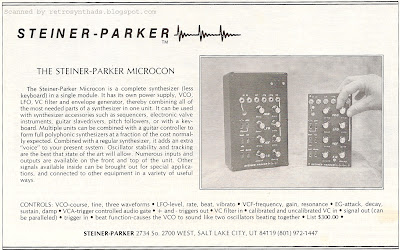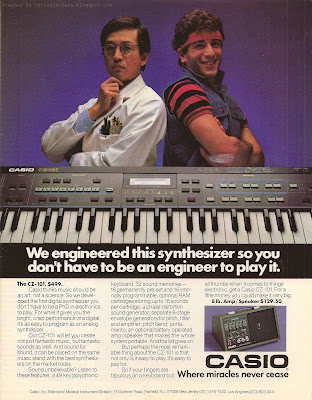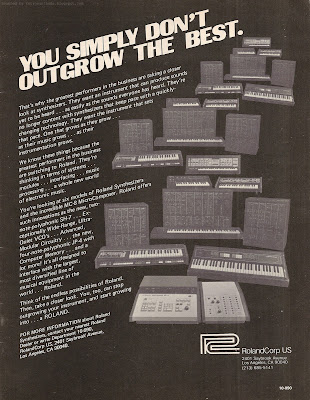
Denis Cazajeux is the man behind
OTO Machines. His first product was the
OTO Biscuit, a bit crushing effects unit with a multi-mode analog filter, waveshaper, delay, pitch shifter, step filter, vibrato, envelope filter, "tube" clipper, and 2 octaves down rectification. He later released
DER OTO, a free monosynth with 16 step sequencer upgrade to the Biscuit. The following is my interview with Denis. You'll find some insight into what influences this unique maker of electronic gear along with his work with Olivier Gillet of
Mutable Instruments (Shruthi-1).
uCApps MIDIBox gets a mention as well. You'll find a pic of Denis' workplace below. The interview:
1) How did the world of synths start for you?
"When I was 15 (in 1986), I started to listen to every electronic music I could find in my country (near the french Alps, in the south east of France): Kraftwerk, Vangelis, Tangerine Dream, Space, Wendy Carlos, Laurie Spiegel, White Noise, Klaus Schulze, etc. At that time, everybody was using a Yamaha DX7 but I was more interested in the Oberheim Matrix 6, Jupiter 8 or Memorymoog, even if I did not have enough money to buy any of these synths. It was a good time for vintage analog synth lovers, they were outdated and cost almost nothing! So I bought a Minimoog, ARP Odyssey, and Korg MS-10. I really love hybrid synths, like the Roland JX series, the Korg Poly-800, Oberheim Matrix-6 or the early 8/12-bits samplers (Ensoniq, E-mu). The sound is generated by a digital counter chip (called a DCO) or a DAC, and then passed through an analog filter.
In 2002, I wanted to build my first little synth and I tried the MIDIBOX SID, based on the MOS 6581 chip, which is also a hybrid synth built in a chip. It was fun but the sound was too '80's video games' (for good reasons!) for me, and the SID chip had a permanent hiss on its output. By the way,
Ucapps (home of Midibox) is a very fascinating website for DIYers. I particularly love their FM synth based on the Yamaha OPL3 chip. If you mix this chip with an analog filter, you'll end up with a warm sounding and powerful synth. When I designed the first Biscuit prototype in 2006, I played with the assembly code to generate sounds through the 8-bit DA converters. It was a very simple synth: only 2 waveforms (square and sawtooth) with digital VCA, and the Biscuit filter controlled by an ADS envelope generator. The sound was surprisingly good, halfway between a SID chip and an analog monosynth. The sample frequency was 30 kHz and because waveforms were not band-limited, I got a lot of aliasing with notes above C3. So I raised the sampling frequency up to 156 kHz to solve this aliasing problem, but then I did not have enough processing power to finish the synth with all the required features (LFO, pitch modulations,...). I gave up and I went back to work on the Biscuit. But I kept in mind that the Biscuit could be a synth one day."

2. Regarding the synthesis work that you initially worked on for the Biscuit, is this what's going into the Der OTO update? How did you manage to work around the processing power?
"I didn't keep anything from the initial work on the Biscuit prototype. My first synth needed a 156 kHz sampling frequency in order to play waveforms without aliasing (I think the SID 6581 also used a very high frequency to solve this aliasing problem). With a standard 40 kHz sampling rate, the sound was good on bass notes, but too dirty for the medium notes and nearly unusable for the high notes. 40 kHz was the upper sampling limit for Biscuit. Biscuit uses a simple 8-Bit PIC microcontroller, clocked at 10 Mhz. This processor has many things to do each second: scanning and computing switches & pots, digitizing audio, receiving and sending MIDI, lighting the LEDs, doing some signal processing (bit manipulation, waveshaper, pitch shifter,...), sending information to the 8-bit DACs, digital pots and analog filter, etc…. So, for the synth upgrade, I had no other choice than to use band-limited waveforms, with interpolation and octave crossfading between wavetables. It was quite complex for me, I'm a self taught guy and I don't have the knowledge to do that kind of stuff. Then I remembered that 2 years ago, I was in touch with Olivier Gillet, creator of the Shruthi-1 monosynth (
http://mutable-instruments.net/). I listened to the Shruthi demos and found that the sound was very impressive for a simple 8-bit monosynth. It was, like Biscuit, 8-bit processing, conversion to analog and an analog filter. Olivier helped me to include band-limited waveforms (Saw and Square) with octave crossfading, FM synthesis and pitch modulation into Biscuit's hardware. He's a brilliant guy, and has a strong knowledge of synthesis and microcontroller programming. It's funny anyway because in the end I added the first raw waveforms to the band-limited ones, to give the choice between a full spectrum playability and a bassy and dirty sound. Dirtiness is useful sometimes!"
3. How much overlap is there with the Shruthi-1?
"Not much. The 2 synths are very different in many points: user interface, number of parameters available, audio path... Der OTO uses 8-bit DAC and Shruthi use a 1-bit 10 MHz PWM. Der OTO got the special 12db/Octave filter that gives Biscuit its particular sound. Shruthi has a 24dB/Oct filter with several choices, Der OTO has a digital VCA instead of its analog counterpart in the Shruthi,... I think that these 2 synths are complementary. Some of our users have both."

4. What made you decide to offer the synth upgrade for the Bicuit for free?
"We wanted to be kind with our customers! It's an anti-capitalist way of doing business, and we love that. Der OTO users can buy the 'Der Mask' overlay, that helps us to fund the development of Der OTO."
5. What is your take on the current world of synthesis and how do you see Der OTO in that world? What inspires you?
"I dream of a simple-low cost-good sounding-polyphonic analog or hybrid synthesizer, that I didn't see yet! OTO is not really in the world of synthesis yet, and Der OTO is maybe just a start, who knows... I think synthesis is like cooking, you need several ingredients to make a good meal. Nowadays, you create loops with a computer, you treat them with analog processors, mix them with an old synth, and then you edit everything in your computer using plugins. It's fusion cuisine, it's very powerful and exciting. I think that 'Der OTO' is a new ingredient for your music. It's not a digital synth, it's not an analog synth, it's between these 2 worlds. When I listen to 'Der OTO', I think it's really musical, wild and its defects are touching!"

6. Anything else you'd like to share with the readers of MATRIXSYNTH?
"I'm just an electronic luthier, I'm waiting to listen what Biscuit users will do with that upgrade!"
7. Speaking of an electronic luthier, Bob Moog always stated he built tools for musicians and wasn't a musician himself. I remember reading he claimed to be first and foremost an engineer. Where do you see yourself? Do you get time to play with your creations and other synths for that matter? When you do, what is a typical session like? Some explore sound and create music in the process, and some pursue music directly.
"It's a very interesting question. I'm not sure if it's possible to be a good engineer and a good musician at the same time. Making (good) music, or designing new musical products takes a lot of time and energy. It's a passion which occupies most of your thoughts. It's the same thing in the world of classical music: the luthiers are not musicians and vice versa. Very few musicians have built their electronic instruments (Raymond Scott, Oskar Sala,...), but their creations were unique and mainly designed for their own use. I used to make music but unfortunately I don't have enough time for that. By the way, I'm not a very good musician! So I see myself more as an engineer, even if I don't have any diplomas in electronics."
I'd like to end this with a big thank you to Denis Cazajeux of
OTO Machines for taking the time out for this interview, and for making the Biscuit. I own one and I can wholeheartedly say it is a fantastic machine.



























































